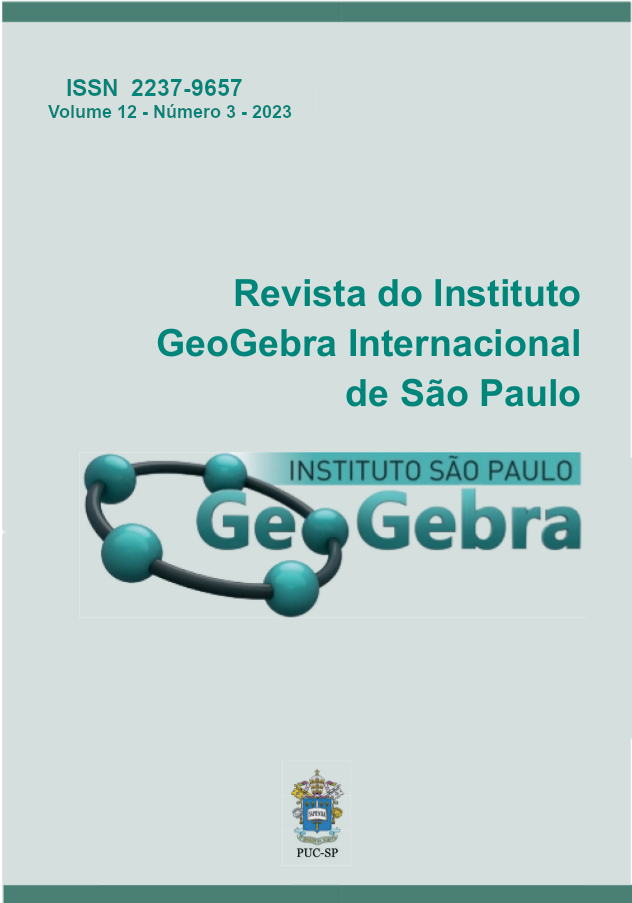Pythagorean theorem using the GeoGebra and GeoGebra Classroom software
DOI:
https://doi.org/10.23925/2237-9657.2023.v12i3p017-036Keywords:
GeoGebra Software, Pythagoras Theorem, GeoGebra Classroom, Interactive and dynamic learningAbstract
This work is part of the Training of Trainers Project and pilot training of mathematics teachers, GeoGebra & STEAM, in Cape Verde. Based on the GeoGebra software and the GeoGebra Classroom platform, it was intended to demonstrate and explore the Pythagoras theorem. This study was motivated by several reasons because we often come across students who have difficulties in understanding some contents and we think that this is due to the lack of methodologies that encourage students and lead them to have another view on mathematics. So, with this work, we intend to contribute to the opening of new paths to success in the teaching of mathematics, through the use of a modern tool and an online collaboration platform, which make it possible to work mathematics in an interactive, dynamic and complete way. Taking into account the objectives of this study, we opted for an essentially qualitative investigation and used quantitative research that fell on document analysis, interaction during classes, student production, photographic recording, questionnaire questions. The work includes several stages, where two questionnaires were applied (initial and final), we planned theoretical classes on the Pythagorean Theorem, and 4 tasks were elaborated to be done in the GeoGebra software and in the end we had a virtual class in the GeoGebra classroom. According to the activities and tasks performed, we concluded that the students showed a lot of creativity, enthusiasm, and greater ability to create their own knowledge. There was greater participation of the students because they posed questions and were always curious about wanting to know more and produce their own works.
References
Bogdan, R.C. & Biklen, S.K. (1994). Investigação qualitativa em educação: Uma Introdução à teoria e aos métodos. Portugal: porto editora.
Canavarro, A.P. & Ponte, J.P. (1997). Matemática e Novas Tecnologias. Lisboa: Universidade Aberta.
Cataneo, V.I. (2011). O uso do software GeoGebra como ferramenta que pode facilitar o processo de ensino aprendizagem da matemática no Ensino Fundamental. Lisboa: Orleans.
Coelho, A.J. (2013). Geogebra e Italc numa nova abordagem criativa das isometrias. Dissertação de mestrado, Departamento de educação- Universidade de Aveiro, Portugal.
Ludke, M. & André, M.E.D.A. (1986). Pesquisa em Educação: Abordagens qualitativas. São Paulo: EPU.
Dos Santos, J. E Reis, I. (2022) “GeoGebra Classroom, em período de confinamento, no ensino e aprendizagem das propriedades dos quadriláteros” Revista do Instituto GeoGebra de São Paulo, v. 11, n. 1,p.118-136,2022-ISSN 2237-9657 in Dialnet-GeoGebraClassroomEmPeriodoDeConfinamentoNoEnsinoEA-8497756 (1).pdf
Silveira, A & Cabrita, I. (2013). O Geogebra como ferramenta de apoio à aprendizagem significativa das Transformações Geométricas Isométricas. Indagatio didática, vol. 5 (1), 149-170.
Hohenwarter, M.& Hohenwater J. (2009). Ajuda GeoGebra: Manual Oficial da versão 3.2. www.geogebra.org
Downloads
Published
How to Cite
Issue
Section
License
Copyright (c) 2023 Revista do Instituto GeoGebra Internacional de São Paulo

This work is licensed under a Creative Commons Attribution 4.0 International License.
Submission, processing, and publication of articles sent to the journal and registration of the DOI at Crossref is free of charge.
Authors retain their copyright and grant the journal the right of first publication of their article, which is simultaneously licensed under a Creative Commons - Attribution 4.0 International license CC BY that allows others to share the article by acknowledging its authorship and initial publication by the journal.
The GeoGebra journal encourages its authors to register their work with information and communication management systems aimed at researchers, such as Academia.edu, Mendeley, ResearchGate, etc.


 10.23925
10.23925
